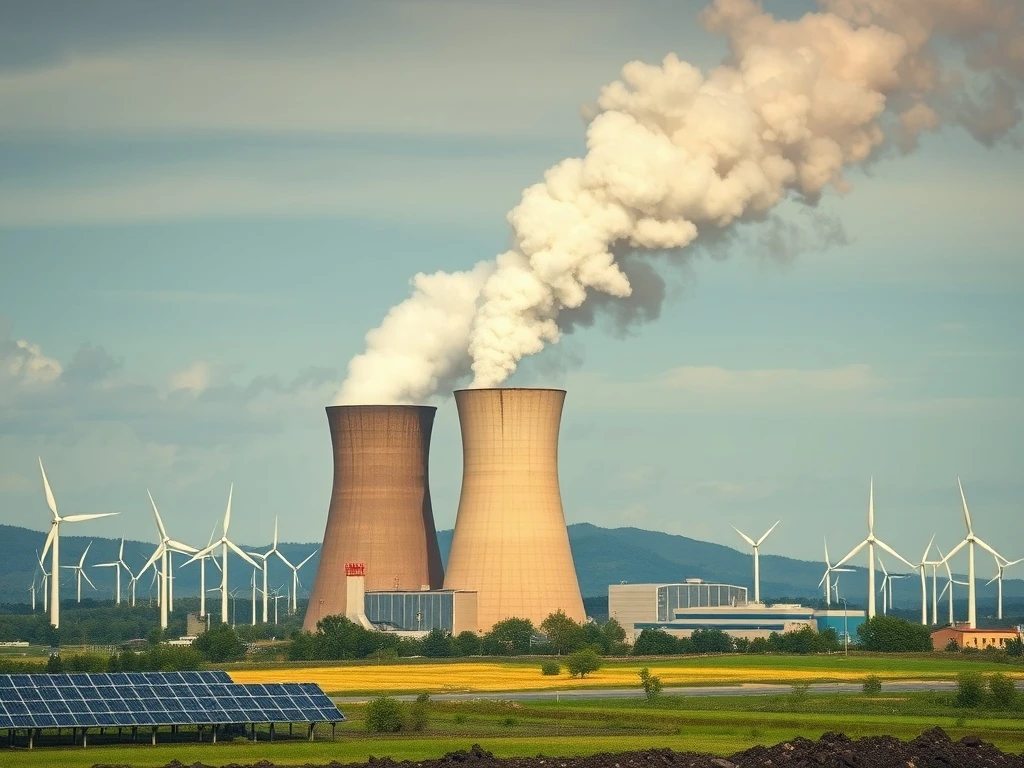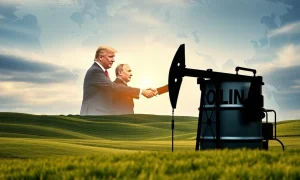For many years, the narrative surrounding coal has been consistently negative. It is often labeled a ‘dirty fuel’ and considered a relic of the industrial past. Yet, for investors and policymakers, understanding coal’s future is critical. Despite widespread efforts to transition to renewable energy sources, coal continues to play a significant role in global energy supply. This enduring presence challenges conventional wisdom and warrants a closer examination of its complex trajectory. Therefore, exploring the factors that contribute to coal’s surprising resilience is essential for anyone interested in global energy markets and strategic investments.
Coal’s Future: Beyond the Dirty Fuel Label
The perception of coal as solely a polluting energy source often overshadows its practical applications and economic realities. Indeed, environmental concerns associated with coal combustion are well-documented. However, a nuanced understanding reveals that coal’s role extends beyond simple electricity generation. Many developing nations, for instance, still rely heavily on coal due to its affordability and abundant supply. Consequently, phasing out coal entirely presents significant economic and social challenges for these regions. Furthermore, coal remains a vital raw material in several industrial processes.
Consider these key points:
- Affordability: Coal is often the cheapest and most readily available energy source in many parts of the world.
- Reliability: Coal-fired power plants provide consistent baseload power, unlike intermittent renewables.
- Industrial Use: Steel and cement production, crucial for infrastructure development, depend heavily on metallurgical coal.
- Energy Security: Countries with domestic coal reserves gain a measure of energy independence.
Ultimately, while the push for decarbonization is strong, the practicalities of global energy demand mean that coal’s future is not as straightforward as many assume. Its continued relevance highlights a complex interplay of economics, geopolitics, and technological advancements.
Global Demand Drivers for Coal’s Future
Despite global climate pledges, several powerful drivers underpin the continued demand for coal. Emerging economies, particularly in Asia, lead this trend. Their rapid industrialization and urbanization require vast amounts of affordable energy. Consequently, coal often fills this gap due to its cost-effectiveness and existing infrastructure. Furthermore, the global energy crisis of recent years has underscored the importance of energy security. Nations prioritize reliable power supply, sometimes at the expense of immediate environmental goals.
Key factors driving demand include:
- Economic Growth: Developing nations need substantial energy to fuel their expanding economies.
- Population Increase: Growing populations require more electricity for homes and businesses.
- Energy Security Concerns: Geopolitical instability prompts countries to diversify energy sources, including coal.
- Industrial Needs: Sectors like steel and cement manufacturing remain heavily reliant on coal.
Therefore, understanding these fundamental demand drivers is crucial when assessing coal’s future. They illustrate a reality where energy transition is a long, complex process, not an overnight shift. This sustained demand, particularly in regions experiencing rapid development, continues to shape global commodity markets and investment opportunities.
Technological Innovations Shaping Coal’s Future
The narrative around coal often overlooks significant technological advancements aimed at mitigating its environmental impact. While challenges remain, innovations are slowly changing the landscape of coal utilization. For instance, High-Efficiency Low-Emissions (HELE) technologies improve the efficiency of coal-fired power plants. This means they produce more electricity with less coal, thereby reducing emissions per unit of energy. Moreover, Carbon Capture, Utilization, and Storage (CCUS) technologies offer a potential pathway to significantly reduce CO2 emissions from coal plants. These systems capture carbon dioxide before it enters the atmosphere, then store or reuse it.
Consider these technological developments:
- HELE Plants: These modern facilities burn coal more efficiently, reducing fuel consumption and emissions.
- CCUS Technology: This captures CO2, preventing its release into the atmosphere.
- Coal Gasification: This process converts coal into a synthetic gas, which can be burned more cleanly or used to produce chemicals.
- Waste Heat Recovery: Systems that capture and reuse heat from power generation improve overall efficiency.
Ultimately, these innovations, while expensive and still developing, represent efforts to make coal a cleaner energy source. Their successful deployment could significantly alter the trajectory of coal’s future, making it a more palatable option in a carbon-constrained world. Investors watch these developments closely, as they could unlock new investment avenues in the sector.
The Geopolitical Chessboard and Coal’s Future
Geopolitical events significantly influence energy markets, and coal is no exception. Recent global conflicts and supply chain disruptions have highlighted the vulnerabilities of relying solely on imported energy. Consequently, many nations are re-evaluating their energy independence strategies. Countries with domestic coal reserves often turn to them during times of crisis. This reduces reliance on volatile international oil and gas markets. For example, the Russia-Ukraine conflict prompted several European nations to temporarily increase coal consumption to ensure energy security. This demonstrated coal’s role as a backup fuel source.
Key geopolitical impacts include:
- Energy Independence: Nations prioritize domestic energy sources, including coal, to reduce external reliance.
- Supply Chain Resilience: Disruptions to oil and gas supplies can lead to a resurgence in coal demand.
- Sanctions and Trade Wars: These can reshape energy flows, favoring readily available commodities like coal.
- National Security: A reliable energy supply is a cornerstone of national security.
Therefore, the geopolitical landscape plays a crucial role in shaping coal’s future. It acts as a reminder that energy policy is not solely about environmental ideals but also about economic stability and national security. This complex interplay ensures coal remains a strategic asset for many governments worldwide, at least in the medium term.
Investment Landscape and Coal’s Future
Investing in coal has become a contentious issue due to environmental, social, and governance (ESG) considerations. Many institutional investors and funds have divested from coal-related assets. However, this divestment has also created unique opportunities for contrarian investors. Reduced institutional ownership can sometimes lead to undervalued assets, particularly if the market overlooks fundamental demand drivers. Furthermore, some coal companies have generated substantial profits in recent years due to surging commodity prices and robust demand. These profits often translate into attractive dividends, drawing in investors seeking yield.
Consider the investment dynamics:
- Contrarian Play: The ‘hated’ status of coal can create undervalued investment opportunities.
- High Dividends: Strong cash flows from current demand can lead to significant shareholder returns.
- Commodity Price Volatility: Coal prices can fluctuate, offering opportunities for traders.
- ESG Challenges: Investors must weigh ethical considerations against potential financial gains.
Ultimately, the investment landscape for coal’s future is bifurcated. On one hand, ESG pressures push capital away. On the other, market realities and short-to-medium-term demand create profitability. This makes coal a complex, yet potentially rewarding, sector for investors willing to navigate its unique challenges and opportunities.
Navigating the Energy Transition: Coal’s Future Role
The global energy transition is undeniably underway, with a strong push towards renewables. However, this transition is not linear. It involves complex challenges, including grid stability, energy storage, and the sheer scale of infrastructure required. In this context, coal often serves as a crucial bridging fuel. It provides reliable baseload power while renewable energy capacity expands. This ensures grid stability and prevents blackouts, which could otherwise hinder economic growth and public acceptance of the transition. Consequently, coal’s continued operation, even at reduced levels, helps manage the risks associated with a rapid shift away from fossil fuels.
Coal’s transitional role includes:
- Baseload Power: Providing a stable, continuous supply of electricity.
- Grid Stability: Balancing the intermittent nature of solar and wind power.
- Energy Security during Transition: Ensuring supply during infrastructure build-out.
- Economic Buffer: Preventing energy price shocks during the shift.
Therefore, recognizing coal’s future as a transitional fuel, rather than an immediate obsolescence, offers a more realistic perspective. Its role will likely diminish over time, but its complete disappearance is not imminent. This pragmatic view acknowledges the immense scale of the global energy system and the practicalities of transforming it.
In conclusion, while environmental concerns correctly highlight coal’s drawbacks, its continued relevance in the global energy landscape is undeniable. Demand from developing economies, technological advancements, geopolitical considerations, and its role as a transitional fuel all contribute to its surprising resilience. Investors and policymakers must acknowledge these multifaceted factors when considering coal’s future. It remains a complex, yet vital, component of the world’s energy mix for the foreseeable future, defying easy categorization or immediate dismissal.
Frequently Asked Questions (FAQs) About Coal’s Future
Q1: Why is coal still used so widely despite environmental concerns?
Coal remains widely used due to its affordability, abundant supply, and reliability. Many developing nations rely on it for economic growth and energy security. Furthermore, industrial processes like steel and cement production still depend heavily on coal.
Q2: What technological advancements are impacting coal’s future?
Key technological advancements include High-Efficiency Low-Emissions (HELE) power plants, which burn coal more cleanly, and Carbon Capture, Utilization, and Storage (CCUS) technologies, which capture CO2 emissions. These innovations aim to reduce coal’s environmental footprint.
Q3: How do geopolitical events affect coal demand?
Geopolitical events, such as conflicts and supply chain disruptions, often increase coal demand. Nations prioritize energy independence and security, turning to domestic coal reserves to ensure a stable power supply and reduce reliance on volatile international markets.
Q4: Is investing in coal still viable, considering ESG pressures?
Investing in coal is contentious due to ESG (Environmental, Social, and Governance) pressures. However, it can offer opportunities for contrarian investors, particularly during periods of high commodity prices. Some coal companies provide attractive dividends due to strong cash flows, despite the long-term shift away from fossil fuels.
Q5: What is coal’s role in the global energy transition?
Coal serves as a crucial bridging fuel during the energy transition. It provides reliable baseload power, ensuring grid stability while renewable energy infrastructure expands. This helps manage the risks and economic impacts of a rapid shift away from traditional fossil fuels.
Q6: Will coal eventually be phased out completely?
While the long-term trend points towards reduced coal usage, a complete global phase-out is not imminent. Its future role will likely diminish, but it will remain a component of the energy mix for the foreseeable future, especially in regions with high energy demand and limited alternatives.
























